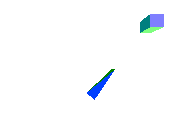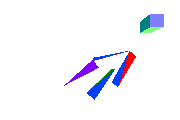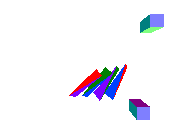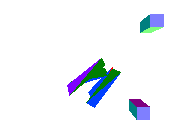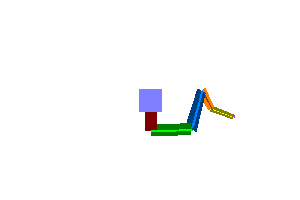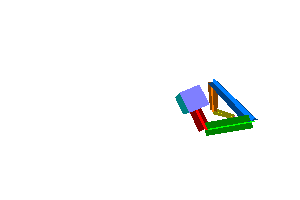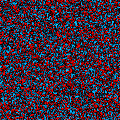1 Overview
This assignment may result in several different programs. Instead of make run we will use several different make targets, one for each broad simulation type.
The required part of this assignment is earn 50 points on this assignment
. The optional part is any points in excess of 50 that you earn.
1.1 make bones file=filename (15–100 points)
This is an extension of HW4: everything that was required in HW4 is required in this program too.
You may find our bones writeup and change of basis writeup to be helpful.
- bone d
This may appear at most once in any
object. If present, it means that this object is considered to be a bone, with object-space origin (0,0,0) and object-space tip (0,0,d).A bone may have geometry, but doesn’t need to. A bone may have the
world, another bone, or a non-bone as its parent.The remaining keywords in this section apply only to bones and will follow the
bonecommand in the input.- track object (requires
bone; 15–30 points) After applying other transformations (including positioning and rotation), rotate the object to the bone’s tip points toward the named object. This should be a minimal rotation to achieve that goal, staying as close to the previous orientation as possible.
- trackroll primary axis secondary (requires
track; 10–20 points) After applying other transformations (including positioning and rotation), rotate the object to the bone’s tip points toward the named primary object. There are many such rotations; pick the one that points the bone’s axis points toward the named secondary object as much as possible. Axis will always be one of
+x,-x,+y, or-y.- trackscale object (requires
track; 10 points) 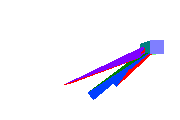 Like
Like track, but also scale along the object’s z axis to that the tip of the bone exactly reaches the given object. Do not scale along the object’s other two axes.- trackstretch object (requires
trackscale; 5 points) 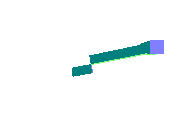 Like
Like trackscale, but also scale uniformly along the object’s x and y axes such that the volume of the bone is conserved.- fabrik object iterations (20–35 points)
Use FABRIK to perform inverse kinematics, where the IK chain consists of this bone and all its bone parents.
Recall that one iteration of FABRIK moves the bone tip to object, then moves the chain root back to its starting location. Compute iterations iterations in total.
Each frame should begin the iteration from the positions provided by any
positionandquaternioncommands. None of the bones in an IK chain will have a track or related command.FABRIK produces the origins and tips of a chain of bones. Use the same math as
positionandtrackto align the bones with these points.
1.2 make fluid file=filename (70–120 points)
This is not an extension of any other assignment. You’ll output 2D fluids directly to the pixels of an image file (I guess we could say it’s an extension of HW0?).
Use back-advection to provide unconditionally stable simulations. When back-advecting off the grid, assume velocity is 0 and temperature is equal to the nearest on-grid temperature.
Fluid simulations tend to be somewhat all-or-nothing: either you have fluid, or you don’t. Thus, you should plan to test each components prior to integrating them. In particular, you’ll need
- A sparse (3–5 nonzero entries per row) positive definite matrix solver.
- Linear-weighted sampling of a grid at non-integer indices
- Sampling a grid with two out-of-bounds rules: either always 0 or nearest in-bounds value
- Back advection of both cell contents and velocity (which means you’ll need two copies of each grid)
- A means of turning a grid of divergences into a single long vector
We recommend using a staggered grid, with velocities on cell boundaries and temperature in cell centers, as this simplifies divergence computation and boundary conditions and makes for nicer results at no additional computational cost.
- pngs width height filename frames
same syntax and semantics as HW0.
Each pixel in the image will represent a cell in a Eulerian fluid grid. Bigger images = higher-resolution fluids. Every cell will be full of fluid.
- heat h bouyancy mag (70 points)

 To create motion in the fluid, track something we’ll call the
To create motion in the fluid, track something we’ll call the temperature
of each pixel. We won’t simulate temperature-based expansion, but will approximate temperature-based buoyancy.We’ll let temperature range from -1 to 1. Each pixel experiences an upward force with strength temperature × bouyancy pixels / frame2.
The input h represents a rate of heat transfer into the fluid. The bottom row of pixels is heated, so t' = h + (1-h)t each frame; the top row is cooled, so t' = -h + (1-h)t each frame.
Use heat as the color of each pixel. Linearly interpolate between the following colors:
Temperature Color 1 #ff00000 #000000-1 #00B2FFIf temperatures are outside this range, you may color them in an implementation-defined manner.
For the first frame, set each cell to have a random temperature between −mag and +mag. This randomization breaks symmetry and gets the simulation started. Because of randomization, each run of a given file will produce a different result (but with the same overall dynamics).
- diffuse rate (10 points)
 Diffuse heat at the given rate each frame using a discrete Gaussian filter with rate as t.
Diffuse heat at the given rate each frame using a discrete Gaussian filter with rate as t.
- viscosity rate (10 points)
 Diffuse velocity at the given rate each frame using a discrete Gaussian filter with rate as t.
Diffuse velocity at the given rate each frame using a discrete Gaussian filter with rate as t.
- subsample n (10 points)
 Render one image every n frames, where n is a positive integer.
Render one image every n frames, where n is a positive integer.for example, if the frames in the
pngsis 100 and the n insubsampleis 4 then you’ll simulate 400 frames but render only 100 images.- confine (requires viscosity; 10 points)
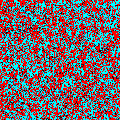
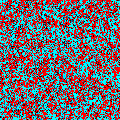 The linear weights involved in advection and the linear approximation of incomprehensibility created by using a matrix both tend to add unwanted
The linear weights involved in advection and the linear approximation of incomprehensibility created by using a matrix both tend to add unwanted numerical viscosity
.As a work-around, if the word
confineappears in the input file then measure the kinetic energy of the fluid before each of these steps and artificially scale all velocities afterward to restore the previously-measured kinetic energy.- tconfine (requires diffuse; 10 points)
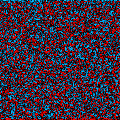
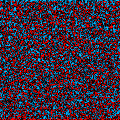 The linear weights involved in advection tends to add unwanted
The linear weights involved in advection tends to add unwanted numerical diffusion
.As a work-around, if the word
tconfineappears in the input file then measure mean and variance of the temperatures fluid before each advection step and artificially shift and scale all temperatures afterward to restore the previously-measured mean and variance.- Other examples
Combined viscosity and diffusion:

Intense starting temperatures with no heating:
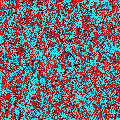
A 40s 720p simulation input file and result (in video player)
1.3 make springs file=filename (50–120 points)
This is not an extension of any other assignment. Rather, it outputs input files for HW3.
This is a mass-spring simulation with moving spheres, fixed planes, and springs. We discussed several approaches to this in class. To replicate my results, each iteration
- draw a frame
- move balls based on gravity and accumulated spring forces
- move anchors
- accumulate spring forces on each ball (without moving them)
- resolve ball-ball collisions from first ball in file to last, moving them to not overlap and updating their velocity
- resolve ball-anchor collisions, moving them to not overlap and updating their velocity
- resolve ball-wall collisions, moving them to not overlap and updating their velocity
I did this in a single pass per time step, acting on the balls in the order I created them. Ball-ball collisions are resolved in order of the first ball in the pair, so the collision of the first and last ball is resolved before the collision of the second and third ball.
This order does mean that a later action cases an earlier fix to be partially undone, but I wanted something easy to describe to increase the chances everyone’s code would make the same animation. That said, I’m not looking for exact similarity: rather, I’m looking for the overall right kind of dynamics.
- txts w h base frames
Create frames different input files for HW3. Each should begin with
pngw h base-frame.pngwhere frame is a 3-digit zero-padded number between 0 and frames − 1. Each should be named base-frame.txt.If the input file opens with
txts 30 40 example- 12when it should make 12 new text files, named
example-000.txtthroughexample-011.txt. The last of these would start with the linepng 30 40 example-011.png- pass through
Any line that is not a command you’ve implemented for this assignment should be passed through as-is in every generated file.
If the input file contains
txts 30 40 example- 1 sphere 1 -0.8 -1 0.5 sphere 0 0 -1 0.3 sun 1 1 1then, because the only line that starts with a HW5 keyword is
txts, the output file will bepng 30 40 example-000.png sphere 1 -0.8 -1 0.5 sphere 0 0 -1 0.3 sun 1 1 1- wall A B C D
Create a barrier ensuring that all balls will remain entirely in the region of space where Ax+By+Cz+D \ge 0.
This line is used only internally and does not appear in any form in the resulting output files.
This barrier is invisible. HW3’s visible variant was
planeA B C D, but visible planes and interacting walls should be handled separately.- ball p_x p_y p_z v_x v_y v_z
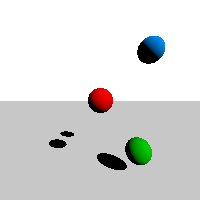 Create an animated ball at location (p_x, p_y, p_z) with velocity (v_x, v_y, v_z). Use the currently active
Create an animated ball at location (p_x, p_y, p_z) with velocity (v_x, v_y, v_z). Use the currently active radiusandmassfor the ball.Each
ballline in the input file becomes asphereline in the output file; in particular,spherec_x, c_y, c_z, r where (c_x,c_y,c_z) is the sphere’s center location on that frame and r is the spheres radius.- ball property specification (extra 5 if do both mass and elasticity)
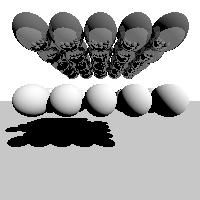 Each of the following sets a value that will be applied to balls created after it. Each may be overridden by appearing multiple times in the input. Each is used only internally and does not appear in any form in the resulting output files.
Each of the following sets a value that will be applied to balls created after it. Each may be overridden by appearing multiple times in the input. Each is used only internally and does not appear in any form in the resulting output files.- radius r
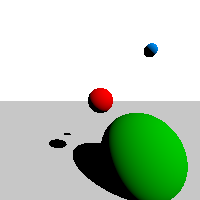 The radius of subsequent
The radius of subsequent balls. At least oneradiuscommand will always precede the firstballcommand.- mass m (5 points)
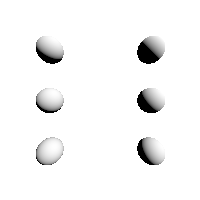 The mass of subsequent
The mass of subsequent balls. If nomasshas been encountered, usemass 1.- elasticity k (10 points)
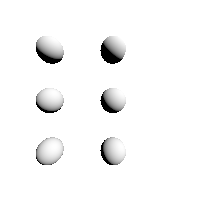
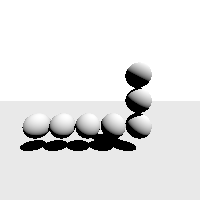 The elasticity of subsequent
The elasticity of subsequent balls. If noelasticityhas been encountered, useelasticity 1.In a ball-wall or ball-anchor collision, the coefficient of restitution used should be the ball’s elasticity. In a ball-ball collision, use the mean of the two elasticities.
- gravity x y z (requires
ball,radius,wall, andtxt; 30 pts) Accelerate all balls by \vec g = (x,y,z) / frame2.
Recall that motion under acceleration works as follows:
- new \vec v = old \vec v + \Delta t \vec g
- new \vec p = old \vec p + \Delta t old \vec v + \frac{1}{2}\Delta t^2 \vec g
- anchor p_x p_y p_z v_x v_y v_z (15 pts)
 Like
Like ball, except an anchor ignores physics; instead it moves at a constant velocity, passing through walls and other anchors. Balls hitting anchors should act like they hit a wall (i.e., use only their own elasticity, not that of the anchor) but should correctly handle velocity added by hitting a moving anchor.- subsample n (10 pts)
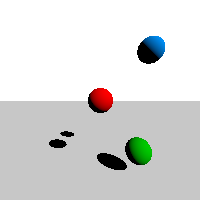
 For each frame, perform n distinct updates. For example, if n=10 then instead of one update of 1 time unit per frame you’d do 10 updates of 0.1 time unit each per frame.
For each frame, perform n distinct updates. For example, if n=10 then instead of one update of 1 time unit per frame you’d do 10 updates of 0.1 time unit each per frame.The math should be such that this makes spring and collision computations more precise but does not change the result of freely-moving balls at all.
- springconst k (requires
subsample,mass, andelasticity) The spring constant of subsequent springs. If no
springconsthas been encountered, usespringconst 0– i.e., ignore the springs.For stability of simulation, it is recommended that input files keep \dfrac{\text{springconst}}{\text{subsample}} < 1.
- tri n a_x a_y a_z b_x b_y b_z c_x c_y c_z (requires
springconstandanchor; 35 pts) 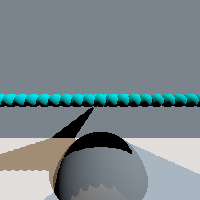 Create a triangle of balls by interpolating between the three given corner ball positions with n+1 balls per side of the triangle. Attach springs in a triangular grid.
Create a triangle of balls by interpolating between the three given corner ball positions with n+1 balls per side of the triangle. Attach springs in a triangular grid.Set all balls to initial velocity 0 and all springs to rest length = their initial length.
tri 3… would produce 10 balls 18 springs arranged as illustrated in the following ASCII art:c / \ * - * / \ / \ * - * - * / \ / \ / \ a - * - * - b- tet n a_x a_y a_z b_x b_y b_z c_x c_y c_z d_x d_y d_z (requires
tri; 10 pts) 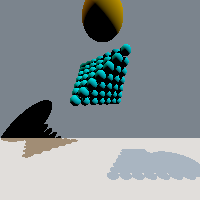 Create a tetrahedreon of balls by interpolating between the four given corner ball positions with n+1 balls per edge of the tetrahedron. Attach springs in a tetrahedral grid.
Create a tetrahedreon of balls by interpolating between the four given corner ball positions with n+1 balls per edge of the tetrahedron. Attach springs in a tetrahedral grid.Set all balls to initial velocity 0 and all springs to rest length = their initial length.
